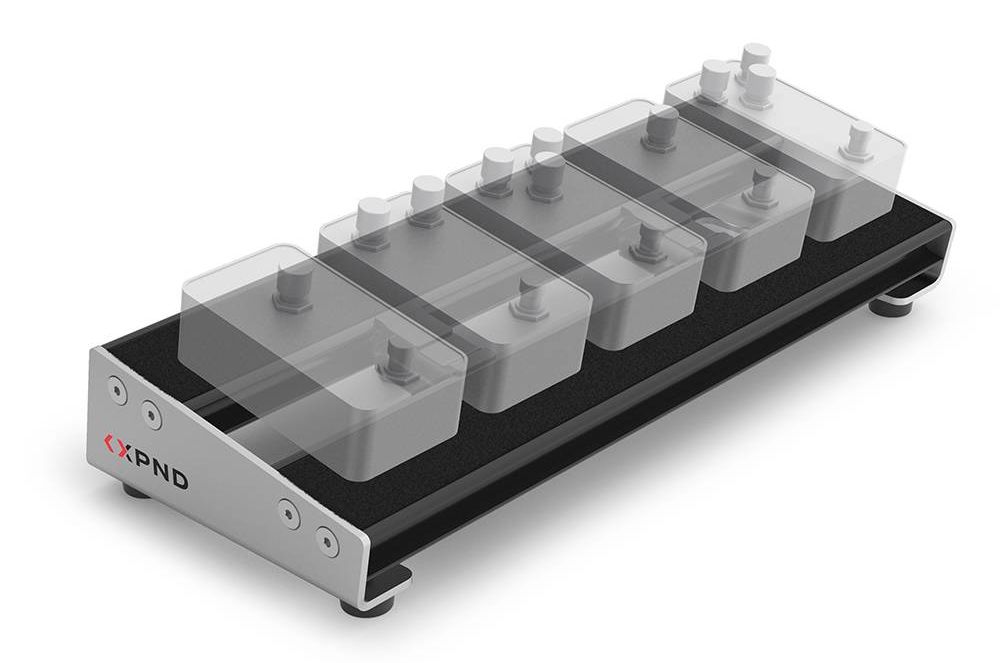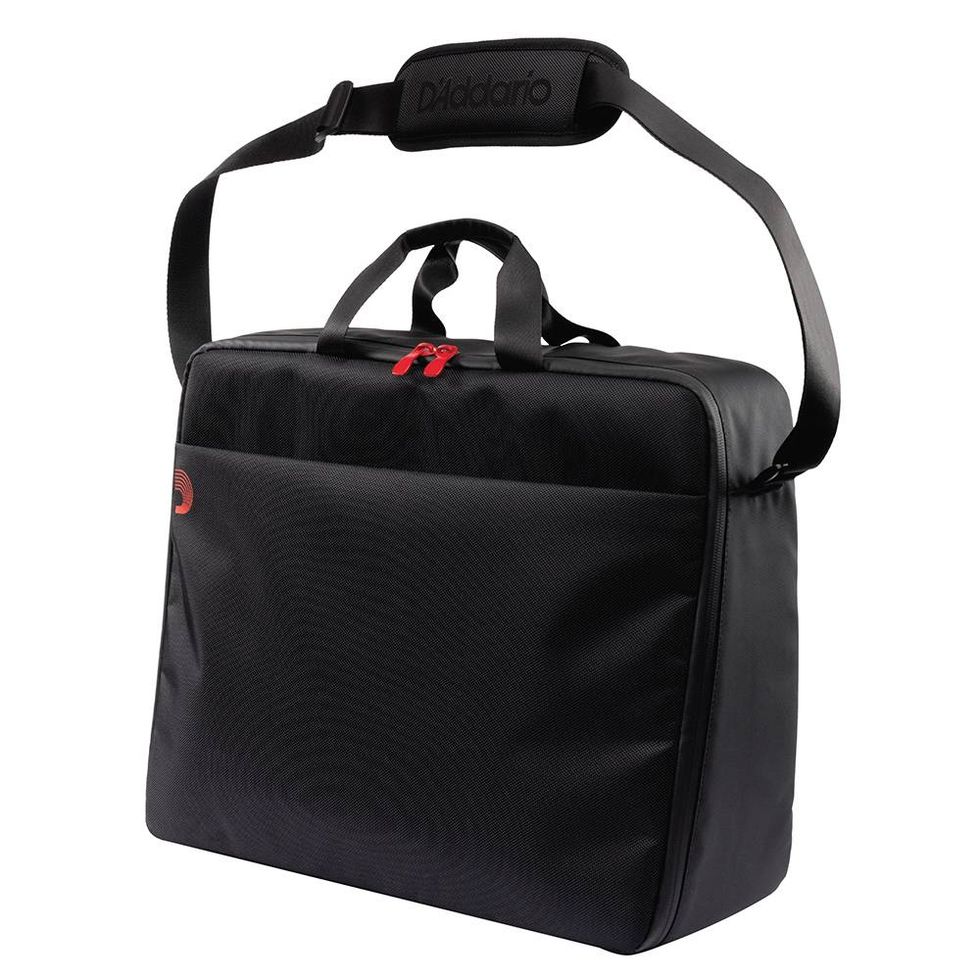| Download Example 1 Fender Strat bridge and center pickup. Modulation position #2. Delay time @ noon. "Drift" breaking after final chord. | |
| Download Example 2 Fender Strat bridge pickup. Modulation position #4. Delay time @ 2 o'clock. | |
| Download Example 3 Gibson SG bridge pickup. Modulation position #5 (too much, too fast). Delay time @ noon. | |
| Download Example 4 Gibson SG bridge pickup. Modulation position #1 (off). Delay time @ 7 o'clock. | |
| All clips recorded into an Electro-Harmonix 44 Magnum, Emperor 4x12" w/Weber C1265s, using a Shure SM57. | |
The Tap-A-Delay, by Michigan’s Cusack Effects, hits the mark on both counts. But what makes the Cusack pedal so appealing— and to some extent, sets it apart—is how it allows you to control it so effectively.
Out-of-the-Box Thinking
For all its capabilities, the Tap-A-Delay is a compact pedal. Even so, there’s plenty of room for a cool engraved logo and a bunch of controls. These include five neon-green chicken head knobs (Level, Mix, Feedback, Delay, and Modulation), two 3-position mini-toggle switches (Mode, Divide), two LEDs (Tempo, Status), and two momentary-style footswitches (Tap Speed, Bypass).
Mono 1/4" input and output jacks, a standard pin-out 9VDC connection, and a special RCA jack that enables you to use the tap-tempo control with other Cusack pedals are easy to access on the back of the unit. It also can be powered via 9V battery. If you like rubber feet, you’ll have to install them yourself or buy a $6 rubber skid pad from Cusack that covers the underside of the pedal. The unit is true bypass (Cusack also sells true-bypass switching systems to use in your own project pedals) and overall, it feels solid, well built, and able to survive the rigors of real-world gigging.
Wealth of Control
The versatility of the Tap-A-Delay is pretty astounding. However, the pedal’s vast capabilities don’t prevent you from quickly and easily accessing a basic, quality delay tone.
The first four knobs operate just as you would expect. Level determines the pedal’s overall volume. The Mix knob controls the volume of the dry signal relative to the delayed signal. Feedback determines how much of the delayed signal gets reprocessed by the effect, and at its maximum setting, you’ll generate what can be a really useful and musical self-oscillation that rumbles like a fleet of helicopters. The Delay knob selects delay times that range from 50 ms to 750 ms. This range is suitable for quick rockabilly slapback, slow Gilmour-esque dreamscapes, and anything in between.
The Modulation control is an 8-position rotary switch that selects from an assortment of modulation presets. Modulation is disabled in position 1. Position 2 introduces subtle modulation to the delayed signal and subsequent positions increase the modulation up to position 5, which Cusack aptly describes as “Too much and too fast.” When used in moderation, these modulations are an excellent addition to the rich delay tones—again inducing thoughts of Gilmour.
Called Warp Up, position 7 initiates a program that steadily increases the delay on a tape delay toward the playback head. Consequently, the delays increase in both speed and pitch, creating a lift-off effect to your riffs. Position 8 is the inverse of position 7, causing the delay to decrease in speed and pitch. Because there are maximum and minimum delay speeds, positions 7 and 8 will snap back to the beginning of their cycle once it has reached maximum or minimum delay. This can sound musically jarring, but effective if you’re ready to hit the bypass switch. Delay speed changes can be overridden at any point with the Tap Speed footswitch. This is not a device that has been stocked with a million studio presets, but rather one that has been carefully designed to respond to your input signal. And the most impressive design feature of this pedal is its potential for musical interactivity.
Beyond Versatility
Thankfully, Cusack Effects believes that no modern delay pedal should be built without a tap-tempo switch. They’ve gone a step further with their 3-position Divide mini-toggle switch that enables you to subdivide your tap rate. The switch’s three settings are eighth-note, dotted eighth-note, and quarter-note. If you prefer fast and synced country/ rockabilly slapbacks, but cannot stomp the footswitch as fast as Dave Lombardo, simply set the Divide switch to eighth-note and tap every beat. The Divide function then interprets incoming taps as quarter-note beats.
The Mode switch also interacts with the Tap Speed footswitch in order to unlock an effect that Cusack refers to as braking. Braking is initiated by holding down the Tap switch and causes the pedal’s delay time to increase or decrease. When the Tap switch is released, the delay times will respond in one of three ways, which is determined by the position of the Mode switch. In Stay mode, the direction (as Cusack terms it) alternates from increase to decrease on each use and the delay time will stay at its last value. Snap mode will return the delay time to its beginning value immediately. Drift mode will return to the initial delay time value gradually. Keep in mind that all of these delay time changes will occur as if you were changing the read/write head positions of a tape delay—pitch bends and all. And it’s awesome for punctuating transitions, adding emphasis to solo crescendos, or spicing up a standard rhythm part. To change the pedal’s braking direction, you hold both footswitches until the Status LED blinks.
Other effects in the Cusack arsenal, including the Tap-A-Whirl (tremolo), Tap-A-Phase (phaser), and Tap-A-Scream (overdrive) include an RCA in/out, which allows the tap tempo to control each of these units. This jack also responds to the input of a momentary footswitch and interfaces with Cusack’s programmable Pedal Board Tamer. While all these functions can sound complicated, they are surprisingly intuitive and intelligently arrayed. And they’re not going to get in your way if you want to use the Tap-A-Delay as a more basic delay.
The Verdict
Unless you’re in dire need of stereo outputs, extremely long delays, or expression pedal control, you really can’t go wrong with the Tap-A-Delay. And if you’re looking to go above and beyond the performance capabilities of the average delay pedal and extend your own creative potential via delay, then I would definitely recommend giving this unit a try. Well engineered, interactive, and player friendly, the pedal delivers tones that are rooted in the warmth and natural taper of vintage analog and tape echo devices. There aren’t too many players in any style who won’t welcome that combination.
Buy if...
you’re looking for a vintage sounding delay with a wealth of interactive performance controls.
Skip if...
you need more than 750 ms of delay, stereo output, expression pedal control, or the ability to store presets.
Rating...
Street $250 - Cusack Effects - cusackmusic.com |





















![Rig Rundown: Russian Circles’ Mike Sullivan [2025]](https://www.premierguitar.com/media-library/youtube.jpg?id=62303631&width=1245&height=700&quality=70&coordinates=0%2C0%2C0%2C0)






